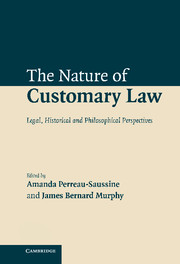Book contents
- Frontmatter
- Contents
- List of contributors
- Table of cases
- The character of customary law: an introduction
- Part I Custom and morality: natural law, customary law and ius gentium
- Part 2 Custom and law: custom, common law and customary international law
- 7 Custom in medieval law
- 8 Siege warfare in the Early Modern Age: a study on the customary laws of war
- 9 The idea of common law as custom
- 10 Three ways of writing a treatise on public international law: textbooks and the nature of customary international law
- 11 Custom, common law reasoning and the law of nations in the nineteenth century
- 12 Custom in international law: a normative practice account
- 13 Customary international law and the quest for global justice
- Index of names
7 - Custom in medieval law
Published online by Cambridge University Press: 30 June 2009
- Frontmatter
- Contents
- List of contributors
- Table of cases
- The character of customary law: an introduction
- Part I Custom and morality: natural law, customary law and ius gentium
- Part 2 Custom and law: custom, common law and customary international law
- 7 Custom in medieval law
- 8 Siege warfare in the Early Modern Age: a study on the customary laws of war
- 9 The idea of common law as custom
- 10 Three ways of writing a treatise on public international law: textbooks and the nature of customary international law
- 11 Custom, common law reasoning and the law of nations in the nineteenth century
- 12 Custom in international law: a normative practice account
- 13 Customary international law and the quest for global justice
- Index of names
Summary
In 1982, in his monograph on custom in the Middle Ages, the Belgian scholar John Gilissen remarked on the lack of studies in English concentrating on the subject. The situation has not improved significantly. Apart from two articles by Albert Kiralfy and one by Paul Brand, such attention as has been given to the topic has been concerned with particular customs, especially manorial customs, borough customs, and the custom of merchants. The present paper will not fill this gap, but will try to set the uses of the idea of custom in England against the better-studied continental background.
Custom in Roman law
Although the part played by custom, consuetudo, in Roman law is outwith the scope of the present paper, many of the ideas found in the Middle Ages were rooted in Roman soil. It cannot therefore be wholly ignored. Two texts in particular were influential, one in the Digest attributed to Julian, but generally regarded as having suffered some post-classical or compilatorial alteration, and one in the Code ascribed to Constantine. Out of these texts, together with some others of less central importance, we may distil a number of points. First, stress is laid on the long-standingness of a practice: it is referred to, for example, as inveterata, longa, or diuturna. Secondly, it is described as flowing from the (tacit) agreement of the people. Thirdly, it is unwritten, contrasted with written lex. Fourthly, it may or may not prevail over a contrary lex.
- Type
- Chapter
- Information
- The Nature of Customary LawLegal, Historical and Philosophical Perspectives, pp. 151 - 175Publisher: Cambridge University PressPrint publication year: 2007
- 17
- Cited by

